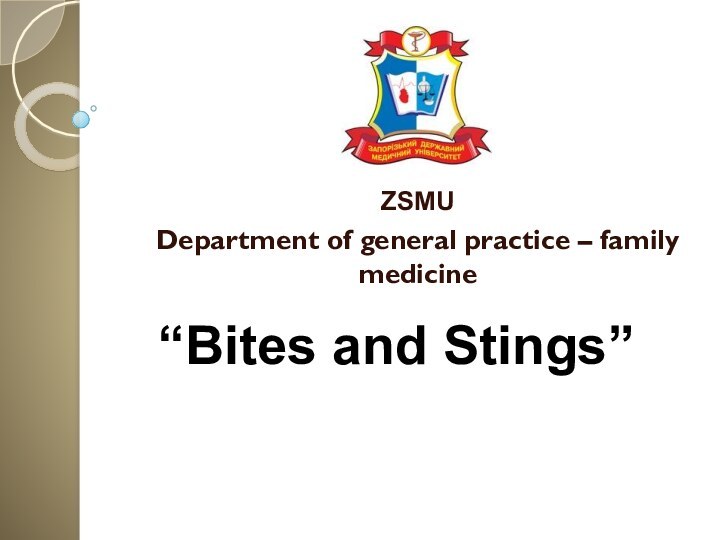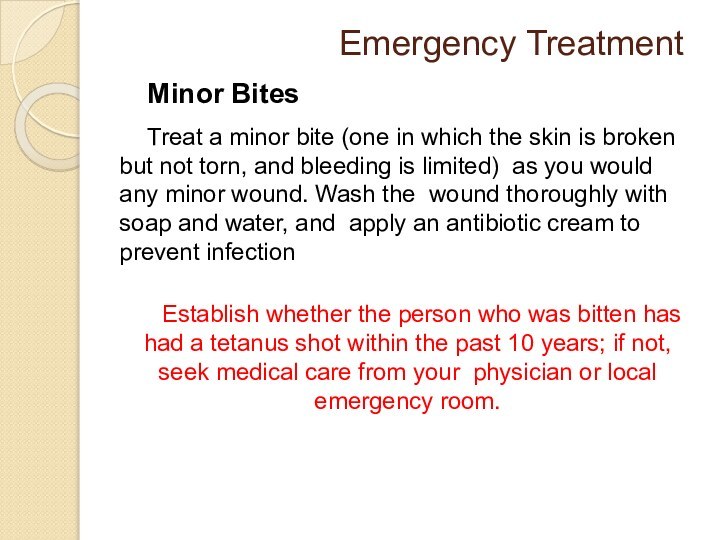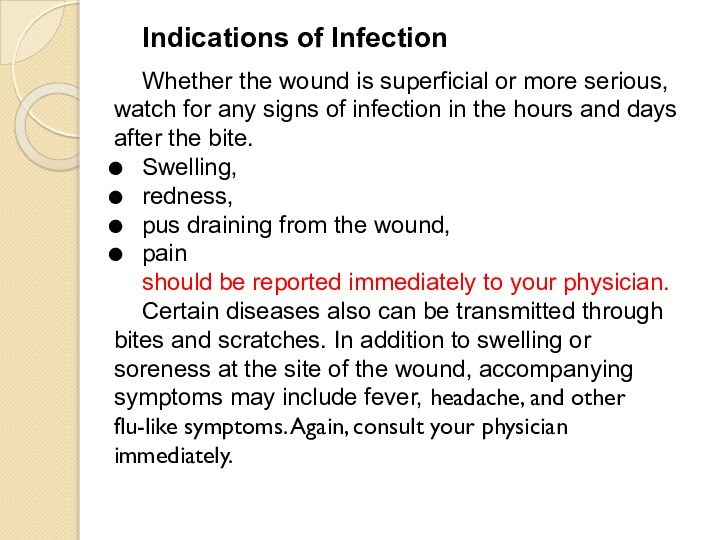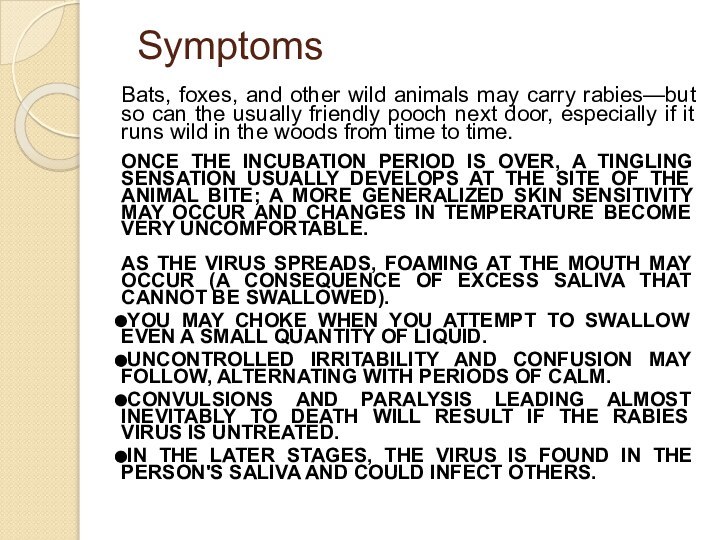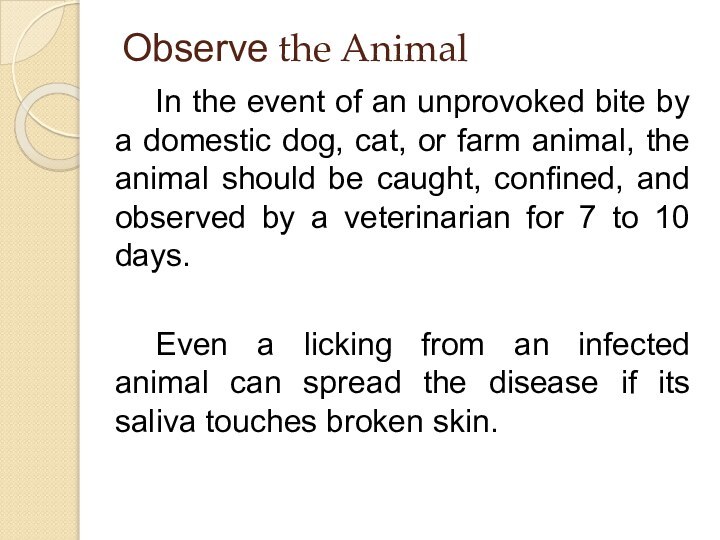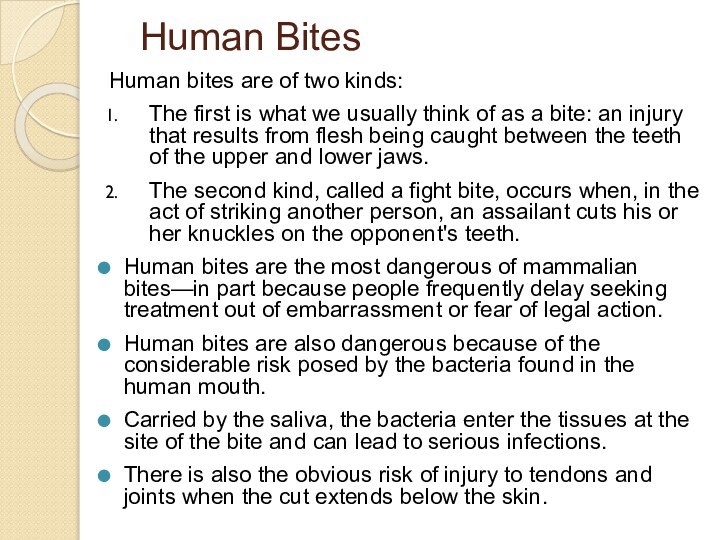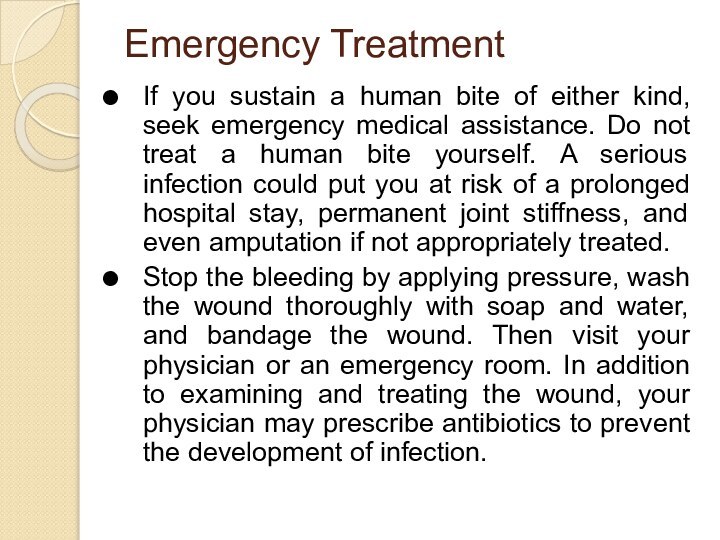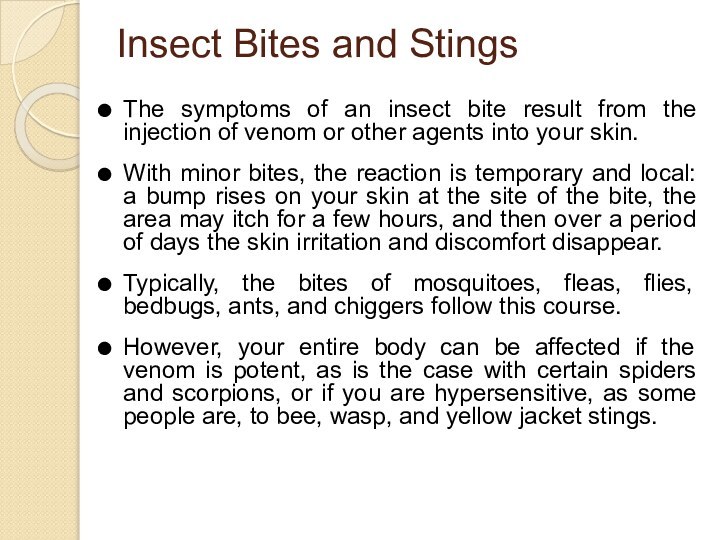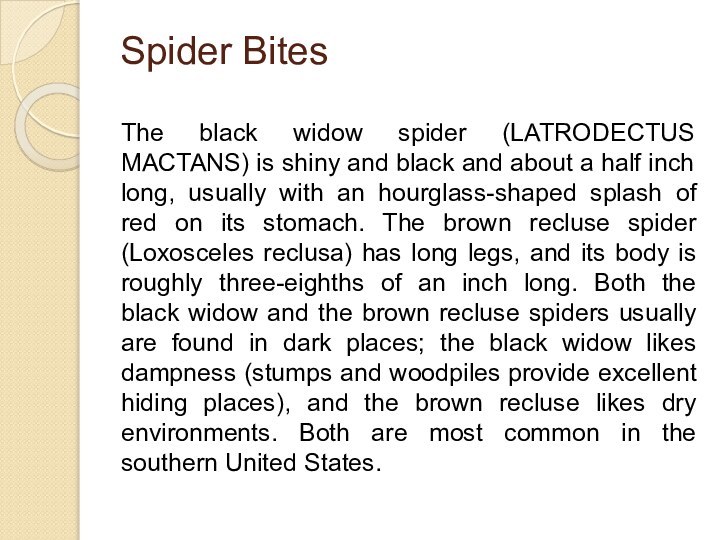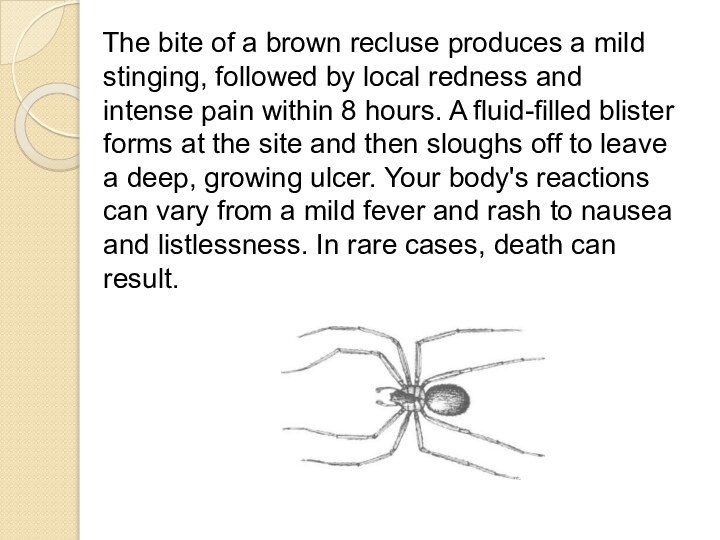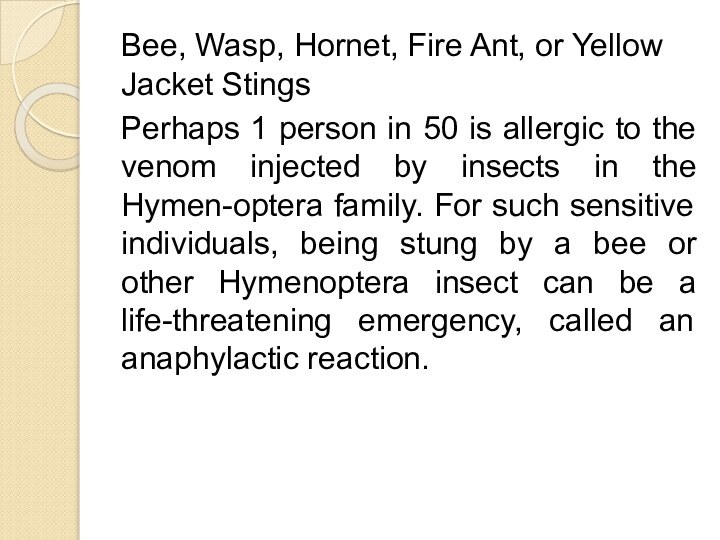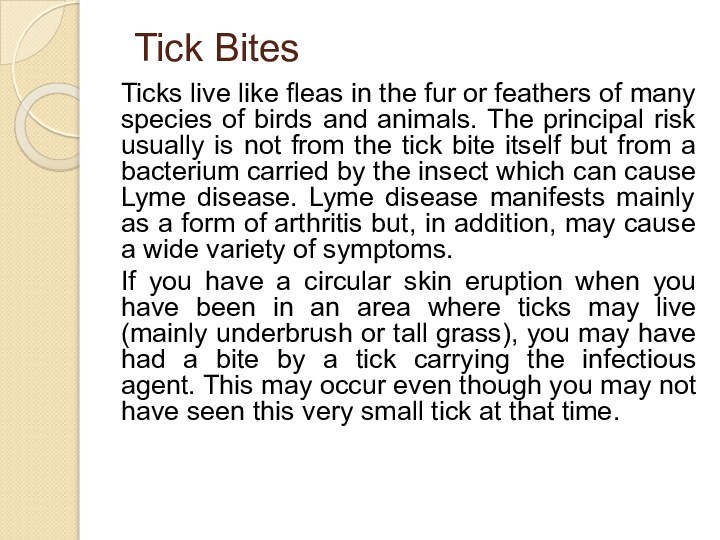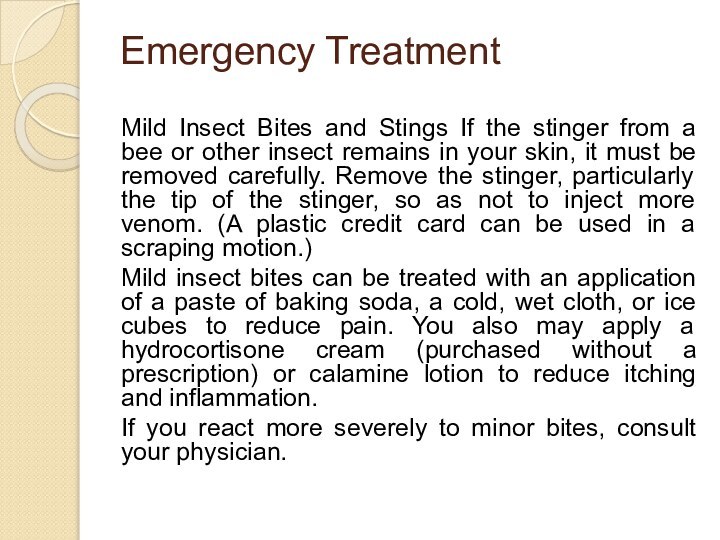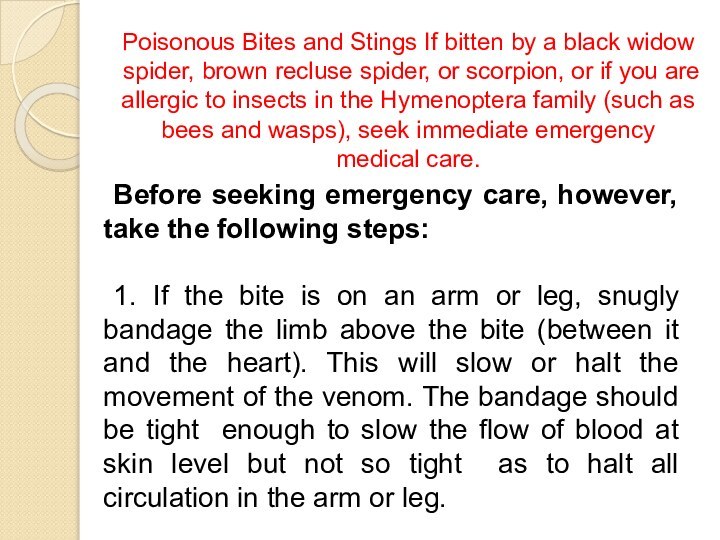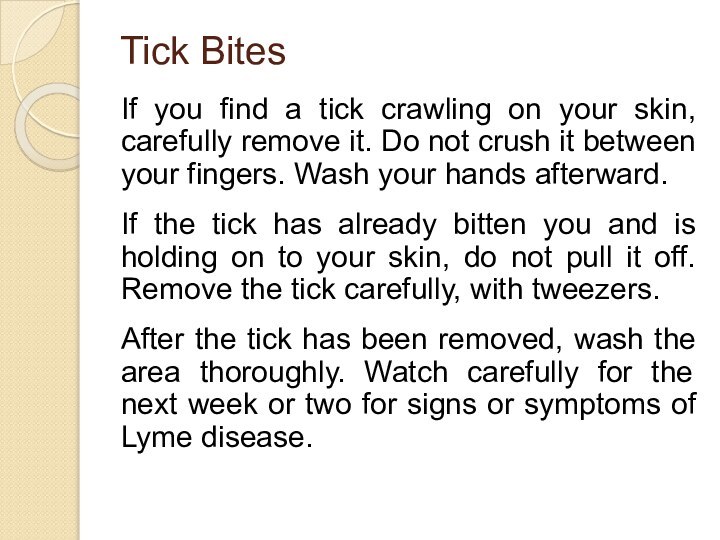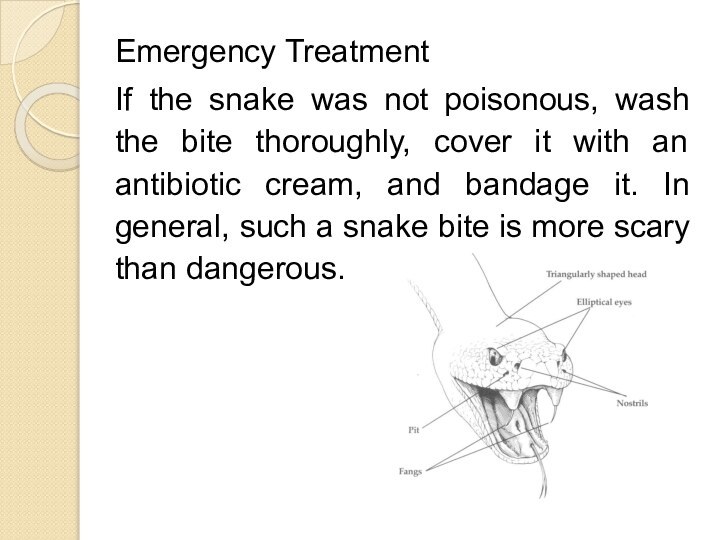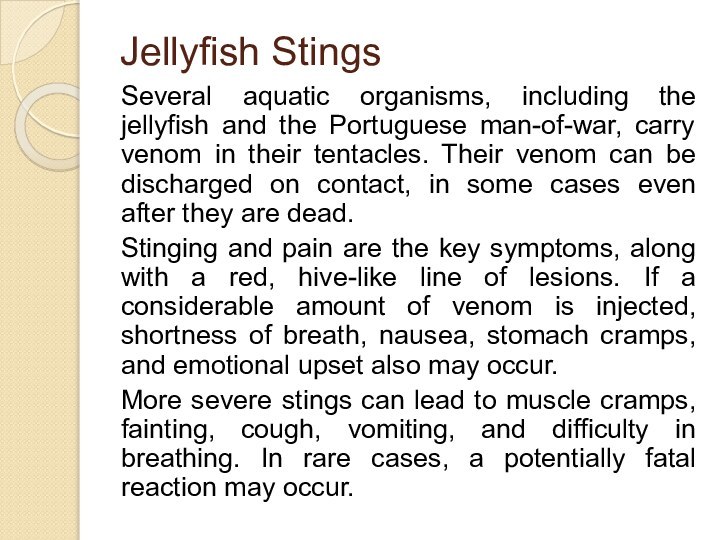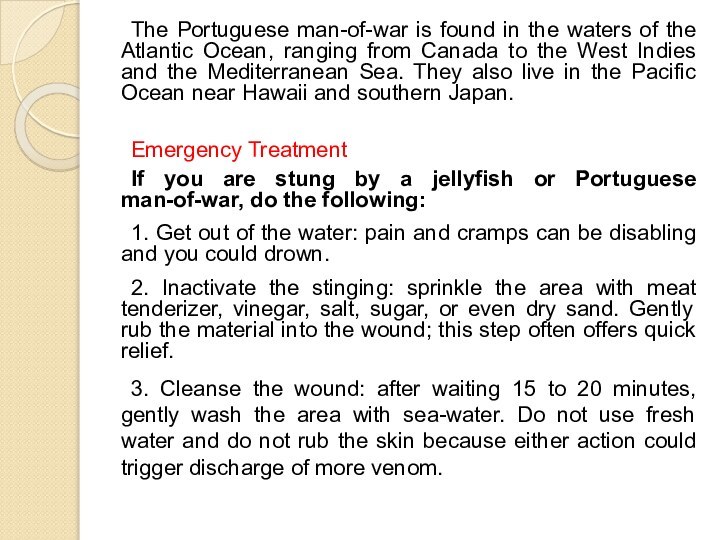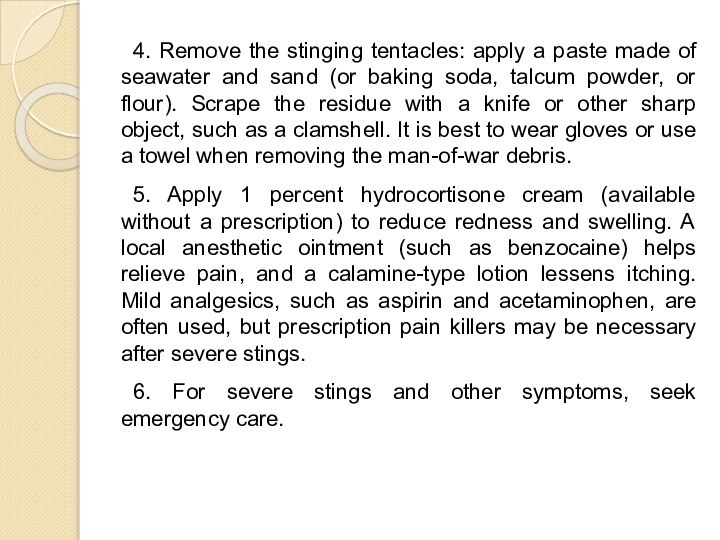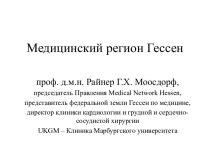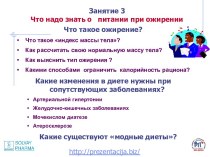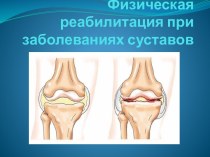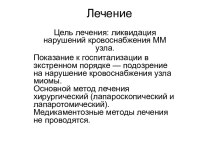Слайд 2
A dog, a bee in a flowering bush,
a spider or a snake, or even another person
can deliver potentially dangerous bites or stings. Every such injury must be treated promptly and properly to minimize the risks of infection, allergic reaction, or other complications.
The following pages discuss animal and human bites; bites by spiders, scorpions, and other insects; bee stings; snake bites; and stings by jellyfish.
Слайд 3
Animal Bites
Domestic pets are the cause of most
animal bites. Dogs are more likely to bite than
cats. However, cat bites are more likely to cause infection. For these reasons, the best treatment for an animal bite is prevention.
Teach your child from an early age not to approach, strange animals. If you have a dog, obey the leash law in your town, and insist that your neighbors do the same. If an animal bites you or another person without provocation, report it to the local authorities. Animals that habitually bite should be constantly restrained or destroyed.
Слайд 4
The vast majority of animal bites are inflicted
by household pets, but strays and wild animals such
as skunks, raccoons, bats, and others also bite thousands of people each year. Animals living in the wild are especially dangerous because they may carry rabies, but any animal that bites a human should be impounded and checked for rabies.
Слайд 5
Emergency Treatment
Minor Bites
Treat a minor bite
(one in which the skin is broken but not
torn, and bleeding is limited) as you would any minor wound. Wash the wound thoroughly with soap and water, and apply an antibiotic cream to prevent infection
Establish whether the person who was bitten has had a tetanus shot within the past 10 years; if not, seek medical care from your physician or local emergency room.
Слайд 6
Serious Bites
If the bite results in a
deep puncture wound, if the skin in the bitten
area is badly torn, or if bleeding persists, apply pressure to stop the bleeding (see How to Stop Severe Bleeding, page 400).
Then seek emergency medical assistance. Your physician will examine, wash, and treat the wound; he or she also may give a tetanus shot (see Tetanus Immunization, page 393).
Слайд 7
Indications of Infection
Whether the wound is superficial
or more serious, watch for any signs of infection
in the hours and days after the bite.
Swelling,
redness,
pus draining from the wound,
pain
should be reported immediately to your physician.
Certain diseases also can be transmitted through bites and scratches. In addition to swelling or soreness at the site of the wound, accompanying symptoms may include fever, headache, and other flu-like symptoms. Again, consult your physician immediately.
Слайд 8
The Risk of Rabies (Recommendation for patients)
Rabies is
caused by a virus that affects the brain. Transmitted
to humans by saliva from the bite of an infected animal, the rabies virus has an incubation period (the time from a bite until symptoms appear) of between 3 and 7 weeks, although it can be much longer (see Rabies, page 1070).
Слайд 9
Symptoms
Bats, foxes, and other wild animals may carry
rabies—but so can the usually friendly pooch next door,
especially if it runs wild in the woods from time to time.
ONCE THE INCUBATION PERIOD IS OVER, A TINGLING SENSATION USUALLY DEVELOPS AT THE SITE OF THE ANIMAL BITE; A MORE GENERALIZED SKIN SENSITIVITY MAY OCCUR AND CHANGES IN TEMPERATURE BECOME VERY UNCOMFORTABLE.
AS THE VIRUS SPREADS, FOAMING AT THE MOUTH MAY OCCUR (A CONSEQUENCE OF EXCESS SALIVA THAT CANNOT BE SWALLOWED).
YOU MAY CHOKE WHEN YOU ATTEMPT TO SWALLOW EVEN A SMALL QUANTITY OF LIQUID.
UNCONTROLLED IRRITABILITY AND CONFUSION MAY FOLLOW, ALTERNATING WITH PERIODS OF CALM.
CONVULSIONS AND PARALYSIS LEADING ALMOST INEVITABLY TO DEATH WILL RESULT IF THE RABIES VIRUS IS UNTREATED.
IN THE LATER STAGES, THE VIRUS IS FOUND IN THE PERSON'S SALIVA AND COULD INFECT OTHERS.
Слайд 10
Observe the Animal
In the event of an unprovoked
bite by a domestic dog, cat, or farm animal,
the animal should be caught, confined, and observed by a veterinarian for 7 to 10 days.
Even a licking from an infected animal can spread the disease if its saliva touches broken skin.
Слайд 11
If a wild animal has bitten you, the
animal should be killed in such a way that
the animal's brain is not crushed or damaged.
Then notify officials at your local health department. They will be able to assist in testing the animal for rabies.
Wild raccoons, skunks, bats, coyotes, and foxes, if not caught, are generally presumed to have rabies.
Слайд 12
Treatment
Extensive cleaning of the wound with soap and
water followed by a second scrubbing with antiseptics should
be carried out as soon as possible after the bite. Your physician must decide whether to treat you for rabies.
Treatment consists of a passive antibody, half injected directly into the wound and half injected into the muscle, and a vaccine, usually given in five injections over 28 days.
Consult Your Physician
If circumstances suggest you may have been exposed to rabies, consult your physician or health department immediately.
Слайд 13
Human Bites
Human bites are of two kinds:
The
first is what we usually think of as a
bite: an injury that results from flesh being caught between the teeth of the upper and lower jaws.
The second kind, called a fight bite, occurs when, in the act of striking another person, an assailant cuts his or her knuckles on the opponent's teeth.
Human bites are the most dangerous of mammalian bites—in part because people frequently delay seeking treatment out of embarrassment or fear of legal action.
Human bites are also dangerous because of the considerable risk posed by the bacteria found in the human mouth.
Carried by the saliva, the bacteria enter the tissues at the site of the bite and can lead to serious infections.
There is also the obvious risk of injury to tendons and joints when the cut extends below the skin.
Слайд 14
Emergency Treatment
If you sustain a human bite of
either kind, seek emergency medical assistance. Do not treat
a human bite yourself. A serious infection could put you at risk of a prolonged hospital stay, permanent joint stiffness, and even amputation if not appropriately treated.
Stop the bleeding by applying pressure, wash the wound thoroughly with soap and water, and bandage the wound. Then visit your physician or an emergency room. In addition to examining and treating the wound, your physician may prescribe antibiotics to prevent the development of infection.
Слайд 15
Insect Bites and Stings
The symptoms of an insect
bite result from the injection of venom or other
agents into your skin.
With minor bites, the reaction is temporary and local: a bump rises on your skin at the site of the bite, the area may itch for a few hours, and then over a period of days the skin irritation and discomfort disappear.
Typically, the bites of mosquitoes, fleas, flies, bedbugs, ants, and chiggers follow this course.
However, your entire body can be affected if the venom is potent, as is the case with certain spiders and scorpions, or if you are hypersensitive, as some people are, to bee, wasp, and yellow jacket stings.
Слайд 16
Spider Bites
The black widow spider (LATRODECTUS MACTANS) is
shiny and black and about a half inch long,
usually with an hourglass-shaped splash of red on its stomach. The brown recluse spider (Loxosceles reclusa) has long legs, and its body is roughly three-eighths of an inch long. Both the black widow and the brown recluse spiders usually are found in dark places; the black widow likes dampness (stumps and woodpiles provide excellent hiding places), and the brown recluse likes dry environments. Both are most common in the southern United States.
Слайд 17
The bite of the black widow spider is
little more than a pinprick-like sensation—some victims are not
even aware of the bite. At first there may be only slight swelling and faint red marks. Within a few hours, however, intense pain and stiffness begin. Other symptoms may include chills, fever, nausea, and severe abdominal pain. The bite is rarely lethal.
Слайд 18
The bite of a brown recluse produces a
mild stinging, followed by local redness and intense pain
within 8 hours. A fluid-filled blister forms at the site and then sloughs off to leave a deep, growing ulcer. Your body's reactions can vary from a mild fever and rash to nausea and listlessness. In rare cases, death can result.
Слайд 19
Scorpion Stings
Scorpions are found in the southwestern United
States. About 3 inches long, they have eight legs
and a pair of crab-like pincers. At the end of their narrow tail is the stinger.
Some scorpions have a potentially lethal venom that is injected by a sting. They live in cool, damp places: basements, junk piles, and woodpiles are favored locations. They tend to be nocturnal, and they are most likely to sting in the cool of the evening.
Because it is difficult to distinguish the highly poisonous scorpions (Centruroides sculpturatus) from the nonpoisonous scorpions, all scorpion stings are to be treated as medical emergencies.
Слайд 20
Bee, Wasp, Hornet, Fire Ant, or Yellow Jacket
Stings
Perhaps 1 person in 50 is allergic to the
venom injected by insects in the Hymen-optera family. For such sensitive individuals, being stung by a bee or other Hymenoptera insect can be a life-threatening emergency, called an anaphylactic reaction.
Слайд 21
Symptoms of such a reaction after a bee
sting may include
swelling around the eyes, lips, tongue, or
throat;
difficulty in breathing;
coughing or wheezing;
and widespread numbness;
or cramping;
hives may appear on the skin;
speech may be slurred;
and anxiety;
mental confusion;
nausea and vomiting;
and unconsciousness may occur.
Слайд 22
Tick Bites
Ticks live like fleas in the fur
or feathers of many species of birds and animals.
The principal risk usually is not from the tick bite itself but from a bacterium carried by the insect which can cause Lyme disease. Lyme disease manifests mainly as a form of arthritis but, in addition, may cause a wide variety of symptoms.
If you have a circular skin eruption when you have been in an area where ticks may live (mainly underbrush or tall grass), you may have had a bite by a tick carrying the infectious agent. This may occur even though you may not have seen this very small tick at that time.
Слайд 23
Emergency Treatment
Mild Insect Bites and Stings If the
stinger from a bee or other insect remains in
your skin, it must be removed carefully. Remove the stinger, particularly the tip of the stinger, so as not to inject more venom. (A plastic credit card can be used in a scraping motion.)
Mild insect bites can be treated with an application of a paste of baking soda, a cold, wet cloth, or ice cubes to reduce pain. You also may apply a hydrocortisone cream (purchased without a prescription) or calamine lotion to reduce itching and inflammation.
If you react more severely to minor bites, consult your physician.
Слайд 24
Poisonous Bites and Stings If bitten by a
black widow spider, brown recluse spider, or scorpion, or
if you are allergic to insects in the Hymenoptera family (such as bees and wasps), seek immediate emergency medical care.
Before seeking emergency care, however, take the following steps:
1. If the bite is on an arm or leg, snugly bandage the limb above the bite (between it and the heart). This will slow or halt the movement of the venom. The bandage should be tight enough to slow the flow of blood at skin level but not so tight as to halt all circulation in the arm or leg.
Слайд 25
Before seeking emergency care, however, take the following
steps:
2. Remain calm. Excessive excitement or activity increases the
flow of venom through your bloodstream
3. Apply a rag dampened with cold water or lined with ice to the bite.
4. Remove the bandage after 5 minutes, but keep the arm or leg dangling down.
5. Seek emergency medical assistance.
Слайд 26
If you know you are sensitive to bee
stings, your physician may provide you with a special
emergency kit containing a single-dose auto-injector or a hypodermic syringe with epinephrine (adrenaline) and an antihistamine pill. Keep this kit handy especially at the time of the year when, or in situations in which, you are at risk of being bitten by an insect in the Hymenoptera family. A person who loses consciousness after a bee sting should be treated for shock.
Слайд 27
Tick Bites
If you find a tick crawling on
your skin, carefully remove it. Do not crush it
between your fingers. Wash your hands afterward.
If the tick has already bitten you and is holding on to your skin, do not pull it off. Remove the tick carefully, with tweezers.
After the tick has been removed, wash the area thoroughly. Watch carefully for the next week or two for signs or symptoms of Lyme disease.
Слайд 28
Snake Bites
Most snakes are not poisonous. However, because
a few are—including rattlesnakes, coral snakes, water moccasins, and
copperheads—avoid picking up or playing with any snake unless you have been trained in distinguishing and handling snakes. If you are bitten by a snake, it is important to be able to determine whether the snake is poisonous. Most poisonous snakes (including the rattlesnake, copperhead, and water moccasin) have elliptically shaped (slit-like) eyes. Their heads are triangular in shape, with a depression or "pit" midway between the eyes and nostrils on both sides of the head (thus the collective name for these snakes, pit vipers). Rattlesnakes are also distinguished by a rattling sound made by the rings at the end of the snake's tail.
The water moccasin has a whitish, cottony lining in its mouth, and the coral snake has red, yellow, and black rings along its length.
Слайд 29
Emergency Treatment
If the snake was not poisonous, wash
the bite thoroughly, cover it with an antibiotic cream,
and bandage it. In general, such a snake bite is more scary than dangerous.
Слайд 30
If, however, you suspect the snake was poisonous,
follow these steps:
1. Remain as quiet and still as
possible after the bite. Lie down quietly and, if possible, keep the bitten area lover than the level of the heart. This position will limit circulation of the venom.
2. If the area changes color, begins to swell, or is painful, the snake was probably poisonous. If the bite is on an arm or leg, tightly bandage the limb a few inches above the bite (between it and the heart). This will also help slow the movement of the venom. The bandage should be tight enough to slow the blood flow at skin level but not so tight as to halt all circulation in the arm or leg. Do not remove the band: the physician will do that.
3. Whether you are positive or uncertain that the snake was poisonous, go to the nearest emergency room as quickly as possible.
Слайд 31
Jellyfish Stings
Several aquatic organisms, including the jellyfish and
the Portuguese man-of-war, carry venom in their tentacles. Their
venom can be discharged on contact, in some cases even after they are dead.
Stinging and pain are the key symptoms, along with a red, hive-like line of lesions. If a considerable amount of venom is injected, shortness of breath, nausea, stomach cramps, and emotional upset also may occur.
More severe stings can lead to muscle cramps, fainting, cough, vomiting, and difficulty in breathing. In rare cases, a potentially fatal reaction may occur.
Слайд 32
The Portuguese man-of-war is found in the waters
of the Atlantic Ocean, ranging from Canada to the
West Indies and the Mediterranean Sea. They also live in the Pacific Ocean near Hawaii and southern Japan.
Emergency Treatment
If you are stung by a jellyfish or Portuguese man-of-war, do the following:
1. Get out of the water: pain and cramps can be disabling and you could drown.
2. Inactivate the stinging: sprinkle the area with meat tenderizer, vinegar, salt, sugar, or even dry sand. Gently rub the material into the wound; this step often offers quick relief.
3. Cleanse the wound: after waiting 15 to 20 minutes, gently wash the area with sea-water. Do not use fresh water and do not rub the skin because either action could trigger discharge of more venom.
